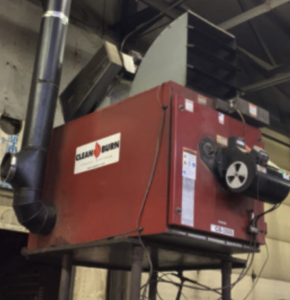
Waste oil recovery unit (oil tank at the bottom)
Waste oil recovery heaters are a very popular method of heating found in workshops and mechanics’ garages across the county. They are very cost-effective because they use the waste oil found in those shops and turn it into free heat. These units are composed of three pieces: the oil tank; the oil pump; and the furnace unit itself.
Waste or used oil is stored in an oil tank. This tank may be located as an attached unit or as a separate unit. These tanks can be stored on the interior or exterior of the building. Attached to the tank is a pump. The pump draws oil from the tank and passes it through a filter. The filter removes any large impurities. The pump provides the necessary oil through the tubing and into the burner assembly.
Depending on the manufacturer, the burner has a fan-assisted atomizer, or the burner is connected to the airline and compressor system. The burner is typically a sealed system that ensures clean combustion; the flame is located in a heat exchanger.

Waste oil recovery unit (heater portion)
A heavy-duty blower forces air around the heat exchanger and out through an opening at the side (or sides) of the unit. The air distributed through the openings is warm and provides comfortable air for the occupied area of the shop.
These units have a flue discharge at the side or on the top of the unit. This is opposite of the burner assembly. This flue system does not require a draft inducer, but it does require a barometric damper. Depending on the unit and manufacturer, the flue temperature can range from 600º F to over 900º F. Assessing this pipe for proper clearances is very important. For additional information about inspecting these systems, download CCPIA’s Waste Oil Recovery Unit Inspection Checklist.
Article Written By: Rob Claus, CMI®
Additional Resources for Commercial Property Inspectors:


